Mike Piazza or Ivan Rodriguez? Ranking MLB's Top 20 Catchers of the 1990s
Joel Reuter@JoelReuterBRMike Piazza or Ivan Rodriguez? Ranking MLB's Top 20 Catchers of the 1990s

Who's ready for some nostalgia? In the weeks to come, we'll take a position-by-position look at the best MLB players of the 1990s.
Up next, the catcher position. Who will claim the No. 1 spot between Hall of Famers Ivan Rodriguez and Mike Piazza?
A player's peak performance, his full statistical body of work during the 1990s and his postseason production were all taken into account when determining the final rankings.
While no single stat was the end-all, be-all in this conversation, OPS+ and WAR/500 are two important ones to know.
OPS+ is a hitter's on-base percentage plus slugging percentage, adjusted to take into account the ballparks in which he is hitting. An OPS+ of 100 is league-average, while each number above 100 represents one percentage point better than the league average.
WAR/500 is my creation. It's a hitter's WAR total divided by his plate appearances and then multiplied by 500, thus giving us his WAR per 500 plate appearances. The idea is to make it easier to contextualize WAR totals across different sample sizes.
Let's kick things off with some honorable mentions.
Honorable Mentions
- Brad Ausmus
- Carlton Fisk
- Darrin Fletcher
- Mike Lieberthal
- Lance Parrish
- Jorge Posada
- Mike Scioscia
- Don Slaught
- Ed Taubensee

These players received serious consideration for the final list but came up short:
20. Rick Wilkins

Postseason: 0-for-1, 1 BB
WAR/500: 2.92
Rick Wilkins had one of the best offensive seasons by a catcher of the 1990s.
In 1993, he hit .303/.376/.561 for a 151 OPS+ with 30 home runs and 73 RBI, good for a 6.6-WAR campaign that was the fifth-highest by a catcher during the decade.
He slumped the following season-plus, and the Chicago Cubs traded him to the Houston Astros for a young Luis Gonzalez and fellow catcher Scott Servais in June 1995.
Wilkins spent just one more year as a starting catcher before settling into a backup role, and he never again hit more than 14 home runs in a season, but his one year of elite production is enough to land him a spot in these rankings.
19. Todd Hundley

Postseason: N/A
WAR/500: 1.37
Todd Hundley became the New York Mets' starting catcher in 1992, and over his first four seasons in that role he posted an 86 OPS+ while averaging 12 home runs and 44 RBI.
He then exploded for a 41-homer, 112-RBI campaign in 1996, setting the single-season record for home runs by a catcher.
Hundley followed that with a 30-homer season and a second straight All-Star selection the following year, but his production quickly diminished afterward.
He averaged just 84 games over the final two years of the decade and hit .196/.286/.394 for a 76 OPS+.
Still, his record-breaking power production at his peak is enough to earn him a spot in these rankings.
18. Dan Wilson

Postseason: 48 PA, .043/.083/.043, 0 HR, 1 RBI
WAR/500: 1.60
The Seattle Mariners acquired catcher Dan Wilson and reliever Bobby Ayala from the Cincinnati Reds for starter Erik Hanson and second baseman Bret Boone before the 1994 season.
Wilson then spent 11 seasons as Seattle's starting catcher, anchoring the pitching staff and serving as a veteran leader in the clubhouse.
He had a quietly excellent three-year peak from 1995 to 1997, hitting .278/.330/.428 for a 95 OPS+ while averaging 14 home runs, 69 RBI and 3.2 WAR, and he earned his lone All-Star selection in '96 when he set career highs in home runs (18) and RBI (83).
He was inducted into the Seattle Mariners Hall of Fame in 2012.
17. Tom Pagnozzi

Postseason: 32 PA, .200/.250/.233, 0 HR, 3 RBI
WAR/500: 1.63
Before Mike Matheny and Yadier Molina won 12 combined Gold Glove Awards for the St. Louis Cardinals in the 2000s and 2010s, Tom Pagnozzi held down the catcher position as a defensive standout.
After four seasons in a backup role behind Tony Pena and Todd Zeile, Pagnozzi took over as the starter in 1991 and posted a career-high 3.0 WAR while winning his first Gold Glove.
He went on to win two more Gold Glove Awards in the next three years, and he spent his entire 12-year career in St. Louis.
He was an All-Star in 1992 and hit a career-high 13 home runs in his final season as an everyday starter in 1996.
16. Ron Karkovice

Postseason: 18 PA, .000/.063/.000, 0 HR, 0 RBI
WAR/500: 2.57
Ron Karkovice had big shoes to fill when he replaced Hall of Famer Carlton Fisk as the Chicago White Sox's starting catcher in 1992.
He spent five seasons as the team's primary backstop, averaging 1.8 WAR per year thanks in large part to his stellar defensive work.
Karkovice led the AL in caught-stealing percentage in 1993 (54 percent), and he nabbed an impressive 41 percent of base stealers during his career.
He slugged double-digit home runs in each of his five campaigns as a starter, including a career-high 20 in 1993 on his way to a 3.2-WAR season.
15. Brian Harper

Postseason: 41 PA, .333/.366/.436, 0 HR, 2 RBI, One-time WS winner
WAR/500: 1.90
A fourth-round pick in 1977, Brian Harper made his MLB debut in 1979. It wasn't until he joined the Minnesota Twins for the 1988 season that he finally carved out a role.
Before that, he spent time with the California Angels, Pittsburgh Pirates, St. Louis Cardinals, Detroit Tigers and Oakland Athletics, playing 205 games in the majors over a nine-year span.
After backing up Tim Laudner in 1988, he moved into the starting role in 1989 and turned in a breakout offensive season in his age-29 campaign.
He spent the first four years of the 1990s as Minnesota's everyday catcher, hitting .304/.339/.428 for a 108 OPS+ while tallying at least 2.0 WAR each season.
He hit .311/.336/.447 with 10 home runs and 69 RBI during the regular season in 1991, and then went 8-for-21 with two doubles during the World Series to help the Twins hoist the trophy.
14. Dave Nilsson

Stats: 3,153 PA, .284/.356/.461 (110 OPS+), 105 HR, 470 RBI, 10.6 WAR
Postseason: N/A
WAR/500: 1.68
Dave Nilsson is arguably the best Australian-born player in MLB history, with a slight edge over relief pitchers Liam Hendriks, Grant Balfour, Peter Moylan and Graeme Lloyd.
Signed by the Milwaukee Brewers in 1987, he made his MLB debut in 1992 and split his time between catcher (309 games), first base (166 games), designated hitter (163 games), right field (105 games) and left field (80 games) over eight MLB seasons.
He broke out in 1996 when he hit .331/.407/.525 for a 131 OPS+ with 33 doubles, 17 home runs and 84 RBI, and he made his lone All-Star appearance in his final MLB season in 1999.
Just 29 years old when he played his final MLB game, he returned to Australia and bought the Australian Baseball League before hitting .565 for Team Australia during the 2000 Olympics.
He is the manager of the Australian national team and the manager of the Brisbane Bandits.
13. Mike Macfarlane

Postseason: 10 PA, .333/.300/.333, 0 HR, 1 RBI
WAR/500: 2.00
Mike Macfarlane made his MLB debut in 1987, and by 1990 he was the Kansas City Royals' starting catcher in his age-26 season.
He led the Royals in home runs in 1992 (17) and 1993 (20), and during the six-year stretch from 1991 to 1996, he posted a 110 OPS+ and averaged 2.1 WAR per season.
On top of his strong offensive numbers, he was also a quality defender with a strong throwing arm, nabbing 33 percent of base stealers during his career.
His lone trip to the playoffs came in 1995 as a member of the Boston Red Sox, and he went 3-for-10 in the ALDS.
12. Benito Santiago

Postseason: 28 PA, .273/.393/.409, 1 HR, 3 RBI
WAR/500: 1.74
Benito Santiago was a rookie sensation for the San Diego Padres when he hit .300/.324/.467 with 33 doubles, 18 home runs and 21 steals to claim NL Rookie of the Year honors and win a Silver Slugger Award.
His 3.4 WAR during that rookie season proved to be the peak of his 20-year career, but he was a solid two-way catcher throughout his tenure and had some notable peaks.
He had a 94 OPS+ and averaged 13 home runs and 61 RBI while playing for the Padres over the first three seasons of the 1990s, earning an All-Star nod each year and starting for the NL squad in 1991 and 1992.
His career carousel started to spin from there, and he spent time with the Florida Marlins, Cincinnati Reds, Philadelphia Phillies, Toronto Blue Jays and Chicago Cubs the rest of the decade. He slugged a career-high 30 home runs for the Phillies in 1996.
11. Charles Johnson

Postseason: 63 PA, .264/.371/.434, 2 HR, 10 RBI, One-time WS winner
WAR/500: 2.82
Charles Johnson was the first player ever drafted by the Florida Marlins organization, going No. 28 in 1992.
He debuted in 1994 and emerged as the team's starting catcher in 1995 when he finished seventh in NL Rookie of the Year voting and won Gold Glove honors, despite playing in just 97 games.
A defensive standout with good power, he won four Gold Gloves during the decade while posting a 92 OPS+ and averaging 16 home runs and 50 RBI from 1995 to 1999.
He was an All-Star in 1997 when he hit .250/.347/.454 for a 113 OPS+ with 19 home runs and 63 RBI to finish 11th in NL MVP voting, and he went 10-for-28 with a home run in the World Series to help the Marlins win a title.
10. Sandy Alomar Jr.

Postseason: 183 PA, .214/.247/.364, 5 HR, 28 RBI
WAR/500: 1.95
Sandy Alomar Jr. was a six-time All-Star during the 1990s, including in 1990 when he won AL Rookie of the Year honors and a Gold Glove Award.
He split time first with Junior Ortiz and then Tony Pena throughout the decade and averaged just 89 games per season. Nevertheless, he was extremely productive when he did play.
During his four-year peak from 1994 through 1997, he posted a 106 OPS+ and averaged 20 doubles, 14 home runs, 53 RBI and 2.1 WAR.
He had a stellar '97 season, hitting .324/.354/.545 with 37 doubles, 21 home runs and 83 RBI to finish 14th in AL MVP voting, and he had five home runs and 19 RBI in 18 games during the postseason that year.
9. Jason Kendall
- 1997: 114 OPS+, .294/.391/.434, 48 XBH, 18 SB, 4.1 WAR
- 1998: 131 OPS+, .327/.411/.473, 51 XBH, 26 SB, 5.6 WAR
- 1999: 137 OPS+, .332/.428/.511, 31 XBH, 22 SB, 4.1 WAR

Postseason: N/A
WAR/500: 3.84
Jason Kendall did not make his MLB debut until 1996, giving him the smallest body of work of anyone in these rankings.
He earned an All-Star selection as a rookie when he hit .300/.372/.401 for a 102 OPS+, tallying 31 extra-base hits and more walks (35) than strikeouts (30) to finish third in NL Rookie of the Year voting.
He followed that with three straight season of at last 4.0 WAR:
With rare speed for a catcher, excellent contact skills and elite on-base ability, he was a valuable offensive weapon on some bad Pittsburgh Pirates teams.
He also controlled the running game well and was a solid all-around defender. The only thing keeping him from ranking higher is the fact that he didn't even play half the decade.
8. Terry Steinbach

Postseason: 46 PA, .302/.348/.372, 1 HR, 6 RBI
WAR/500: 2.32
An All-Star in 1988 and 1989, Terry Steinbach was already well-established as the starting catcher of some terrific Oakland Athletics teams when the 1990s arrived.
He spent the first seven seasons of the decade in Oakland, posting a 106 OPS+ and averaging 14 home runs, 63 RBI and 2.6 WAR per season.
He was an All-Star again in 1993, and he enjoyed the best offensive season of his career in 1996 when he hit .272/.342/.529 for a 116 OPS+ while setting career highs in hits (140), home runs (35), RBI (100) runs scored (79) and total bases (272).
The Twins signed him as a free agent in 1997, and he spent the final three seasons of his career in Minnesota.
7. Mickey Tettleton

Postseason: 17 PA, .083/.353/.083, 0 HR, 1 RBI
WAR/500: 2.54
Mickey Tettleton was six years into his MLB career and fresh off an All-Star appearance and Silver Slugger Award when the decade began.
After a down year in 1990, he was traded from Baltimore to Detroit, where he quickly rebounded and put together a stellar four-year run. During his time with the Tigers, he posted a 135 OPS+ while averaging 28 home runs and 83 RBI with a .387 on-base percentage on the strength of an 18.3 percent walk rate.
During that four-year stretch, he won two more Silver Slugger Awards and made his second All-Star appearance in 1994.
He signed with the Texas Rangers for the 1995 season and split his time between right field and designated hitter, with Ivan Rodriguez handling catching duties. He continued to be an offensive weapon during his first two seasons in Texas with a .242/.380/.478 line and 115 OPS+ while averaging 28 home runs and 80 RBI.
6. Mike Stanley

Postseason: 83 PA, .356/.434/.466, 1 HR, 7 RBI
WAR/500: 2.78
Mike Stanley spent the first six seasons of his career with the Texas Rangers, logging a forgettable minus-0.3 WAR in 452 games.
He joined the New York Yankees in free agency before the 1992 season and put up solid numbers while serving as backup to Matt Nokes with a 125 OPS+ and eight home runs in 207 plate appearances.
In his age-30 season the following year, he broke out in a big way with a .305/.389/.534 line for a 150 OPS+ with 26 home runs and 84 RBI to claim Silver Slugger honors and finish 13th in AL MVP voting.
He remained a top-tier offensive producer the rest of the decade, hitting .281/.380/.500 for a 127 OPS+ while averaging 21 home runs and 73 RBI from 1993 through the 1999 campaign.
His defensive skills lagged behind his offense, and he spent more time at designated hitter and first base during the final three years of the decade, but his steady offensive production deserves recognition.
5. Javy Lopez

Postseason: 162 PA, .292/.346/.514, 7 HR, 22 RBI, One-time WS winner
WAR/500: 2.52
A hyped prospect during his time in the Atlanta Braves farm system, Javy Lopez saw his first extended MLB action in 1994 when he split catching duties with Charlie O'Brien and finished 10th in NL Rookie of the Year voting.
The following season he hit .315/.344/.498 for a 117 OPS+ with 14 home runs and 51 RBI in 352 plate appearances, and from there he quickly emerged as one of baseball's most productive offensive catchers.
He made All-Star appearances in 1997 and 1998, earning some down-ballot MVP support in '98 when he had a 34-homer, 106-RBI season.
Add to that his strong postseason performance, which included 1996 NLCS MVP honors when he went 13-for-24 with five doubles and two home runs, and he vaults into the top five.
4. Chris Hoiles

Postseason: 49 PA, .150/.306/.300, 2 HR, 3 RBI
WAR/500: 3.54
Chris Hoiles spent his entire 10-year career with the Baltimore Orioles, and nine of those seasons occurred during the 1990s.
In his eight years as Baltimore's starting backstop, he hit .264/.369/.472 for a 121 OPS+ while averaging 19 home runs and 55 RBI.
He never made an All-Star team, but he had one of the best seasons of the decade by a catcher in 1993 when he hit .310/.416/.585 with 28 doubles, 29 home runs and 82 RBI for a 6.8-WAR season.
All told, he topped 2.0 WAR six times, providing elite offensive production at the position to go along with quality defense.
3. Darren Daulton
- 1992: 156 OPS+, .270/.385/.524, 27 HR, 109 RBI, 6.9 WAR
- 1993: 136 OPS+, .257/.392/.482, 24 HR, 105 RBI, 5.0 WAR

Postseason: 80 PA, .281/.413/.516, 3 HR, 10 RBI
WAR/500: 3.38
Darren Daulton was the heart and soul of a Philadelphia Phillies team that reached the World Series in 1993, and he posted two of the best all-around seasons of the 1990s by a catcher.
A 25th-round pick in 1980, he was a bona fide superstar in 1992 and 1993:
He was an All-Star in both of those seasons, finishing sixth in NL MVP voting in '92 and seventh in the balloting in '93.
That two-year stretch represented his peak, but he was a solid two-way performer throughout the 1990s, and he went 7-for-18 with a home run during the 1997 World Series to win a ring in his final MLB season.
2. Ivan Rodriguez

Postseason: 41 PA, .263/.300/.316, 0 HR, 3 RBI
WAR/500: 3.95
Ivan Rodriguez made his MLB debut at 19 years old in 1991 and went on to finish fourth in AL Rookie of the Year voting, despite playing in just 88 games.
From there, he won a Gold Glove and made the All-Star team in each of the remaining eight years of the '90s, adding six Silver Slugger Awards for good measure.
Rodriguez was defensive standout from the onset of his career, but his offensive game steadily improved, culminating in AL MVP honors during the 1999 season when he hit .332/.356/.558 for a 125 OPS+ with 35 home runs, 113 RBI, 116 runs scored and 25 steals in a 6.4-WAR season.
His 25.5 WAR over the final four years of the decade trailed the totals of only Ken Griffey Jr. (30.4), Barry Bonds (29.7), Jeff Bagwell (28.9), Alex Rodriguez (28.3) and Craig Biggio (26.5).
He wrapped up his 21-year career as a 14-time All-Star, 13-time Gold Glove winner and seven-time Silver Slugger winner, earning Hall of Fame induction in his first year on the ballot in 2017.
1. Mike Piazza

Postseason: 61 PA, .211/.230/.333, 2 HR, 7 RBI
WAR/500: 5.10
The WAR/500 difference between Mike Piazza (5.10) and Rodriguez (3.95) made the No. 1 spot in these rankings a fairly easy decision.
One of the greatest steals in MLB draft history, Piazza was selected in the 62nd round in 1988. He made his MLB debut Sept. 1, 1992, and he took over as the Los Angeles Dodgers' starting catcher the following year.
His rookie season was one of the best in history as he hit .318/.370/.561 for a 153 OPS+ with 35 home runs and 112 RBI en route to 7.0 WAR to finish ninth in NL MVP voting and become the NL Rookie of the Year.
He won Silver Slugger honors and finished 14th or higher in NL MVP voting in each of his seven full seasons during the decade, averaging 34 home runs and 109 RBI with a 158 OPS+ during that span.
While he was never a standout defender, he also wasn't nearly as bad as his reputation sometimes suggests. He had a negative dWAR just once during the 1990s, and he threw out at least 24 percent of base stealers in all but one of season.
The No. 1 spot in these rankings was clearly a two-man race, but Piazza's gaudy offensive totals put him on top.
All stats courtesy of Baseball Reference and FanGraphs unless otherwise noted.
Catch up on past "Top 20 of the 1990s" articles: First Basemen, Shortstops, Third Basemen
B/R Recommends
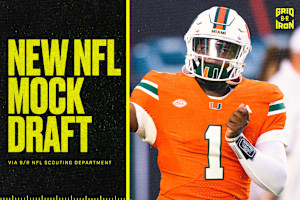
2025 NFL Mock Draft: B/R NFL Scouting Dept.'s Post-Super Bowl Picks
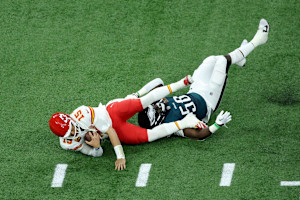
Patrick Mahomes Takes Blame for Chiefs' Loss: 'I Just Didn't Play to My Standard'
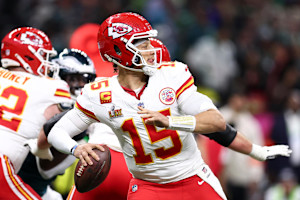
Patrick Mahomes' Legacy Doesn't Compare to Tom Brady After Super Bowl LIX Rout
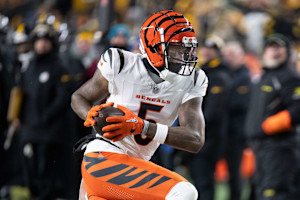
NFL Free Agency 2025: Start Date, Salary Cap, Rumors and Early Predictions
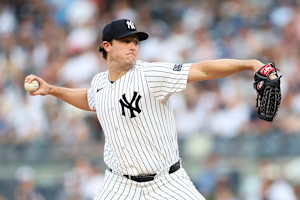
Predicting Every MLB Team's 2025 Opening Day Starting Rotation, Version 3.0
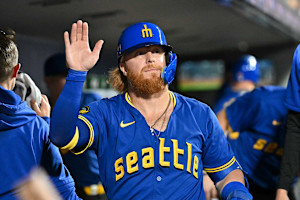
Best Landing Spot For Top 7 Remaining MLB Free Agents
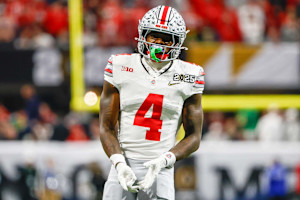
Projecting College Football's Top 7 Receiving Stars in 2025
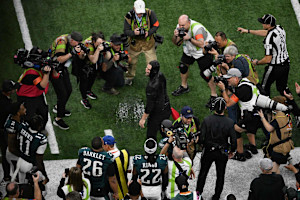
Super Bowl 60 Odds: Eagles, Chiefs, Bills Open as Favorites to Win 2025-26 NFL Title
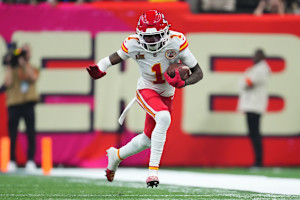
Xavier Worthy Sets NFL Super Bowl Rookie Record in Chiefs' Loss to Eagles
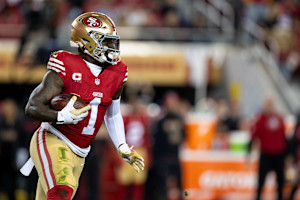
Realistic Trade Packages for Deebo Samuel After 49ers WR Requests Move





























